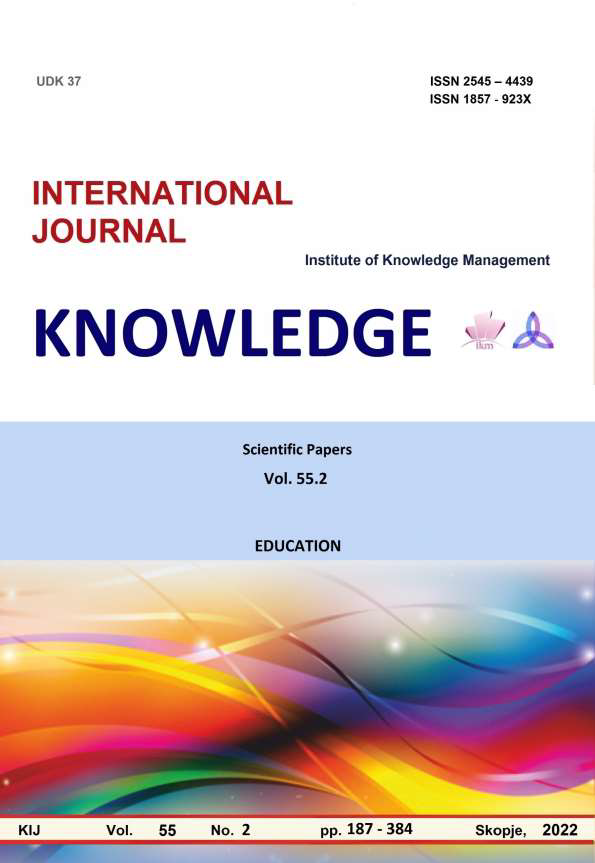EDUCATION ON SOCIAL MEDIA PLATFORMS AS LEARNING AND DEVELOPING RESOURCE
Keywords:
online learning, social media, education, young woman, scienceAbstract
Formal and informal education through social media platforms is an important source of knowledge.
They are accessible to any user, require limited mobility, and provide enormous learning opportunities. Online
learning through social media after the COVID-19 pandemic is more available, accessible, and possible to the
diverse learner population globally. In 2022, women are more open for education and have increased use of social
media for different educational opportunities, both formal and informal, but there is still gender bias and inequality
in STEM (Science, Technology, Engineering, Mathematics) fields and the digital sector (e.g., digital technologies,
Computer Science, Information Technology, Information and Communication Technology, Artificial Intelligence,
cybersecurity).
The main objective of the research was to examine the role of available social platforms in educational and learning
purposes for young women in Serbia. The research targeted young women, aged 18-32, actively participating and
educating at the University of Kragujevac and the University of Priština, with temporary head office in Kosovska
Mitrovica, in the Republic of Serbia. Data was collected through implementation of five focus groups, with 40
respondents. The method used for the research is both qualitative and quantitative. The research contained several
different categories: educational and learning purposes of social media platforms, networking between scientific
workers, presentation of new scientific achievements and information sharing between scientific workers and the
wider public, and practical implementation of the skills learned through social media platforms. Collected data was
processed qualitatively in the MAXQDA program and quantitatively in the SPSS program. Results showed that
women do not only empower themselves enough with the exploration of online resources but also others when they
teach online, actively share information on social media, but less participate in online discussion forums. On the
other side, research showed the gap in communication between the scientific workers and the wider media as well as
the lack of modern and innovative networking mechanisms. Those findings will encourage academic and scientific
workers to support and use social media to outreach and dissemination the data and use them in the developing,
networking, and learning context.
References
Alnjadat, R., Hmaidi, M. M., Samha, T. E., Kilani, M. M., & Hasswan, A. M. (2019). Gender variations in social media usage and academic performance among the students of the University of Sharjah. Journal of Taibah University Medical Sciences, 14(4), 390–394. https://doi.org/10.1016/j.jtumed.2019.05.002
Arquero, J. L., & Romero-Frías, E. (2013). Using social network sites in Higher Education: an experience in business studies, Innovations in Education and Teaching International, 50(3), 238-249, DOI: 10.1080/14703297.2012.760772
Bouton, E. & Asterhan, C. S.C., (2017). Teenage peer-to-peer knowledge sharing through social network sites in secondary schools. Computers & Education, 110, 16–34. https://doi.org/10.1016/j.compedu.2017.03.007
Chugh, R., & Ruhi, U. (2018).Social media in higher education: A literature review of Facebook. Educ Inf Technol 23, 605–616 . https://doi.org/10.1007/s10639-017-9621-2
Greenhow, C., & Askari, E. (2017). Learning and teaching with social network sites: A decade of research in K-12 related education. Educ Inf Technol 22, 623–645. https://doi.org/10.1007/s10639-015-9446-9
Heidi, H., Smith, E.A.,, Kim, H.J., & Meister, P. (2019) “The Gender Readings Gap in Political Science Graduate Training” Journal of Politics. https://doi.org/10.1086/704784)
Hurt, N. E., Moss, G. S., Bradley, Ch. L., Larson, L. R., Lovelace, M., Prevost, L. B., Riley, N., Domizi, D., & Camus, M. S. (2012) "The ‘Facebook' Effect: College Students' Perceptions of Online Discussions in the Age of Social Networking," International Journal for the Scholarship of Teaching and Learning: 2 (6) https://doi.org/10.20429/ijsotl.2012.060210
Kiera, Ch., Stephanie, S. M., Ruchira, T. N., & Kathryn, M. Y. (2022). Beyond Girls’ Education: Pathways to Women’s Post-Marital Education in Matlab, Bangladesh, Feminist Economics, DOI: 10.1080/13545701.2022.2082510
Mavrodieva, A., & Rachman ,O. (2019). Role of Social Media as a Soft Power Tool in Raising Public Awareness and Engagement in Addressing Climate Change (122; https://doi.org/10.3390/cli7100122)
Murphy, L., & Luo, J. (2016). Using Social Media to Promote STEM Education: Matching College Students with Role Models (LNAI, volume 9853)
Sarsons, H. (2017). Recognition for Group Work: Gender Differences in Academia, American Economic Review: Papers & Proceedings. 107(5), 141–145.
Thanavathi, C. (2022). “The powerful influence of social media on women’s education” Shodha Prabha (UGC CARE Journal): 15 (47), ISSN: 0974-8946





